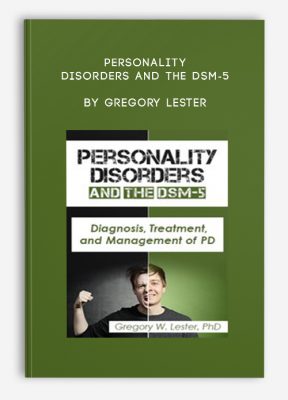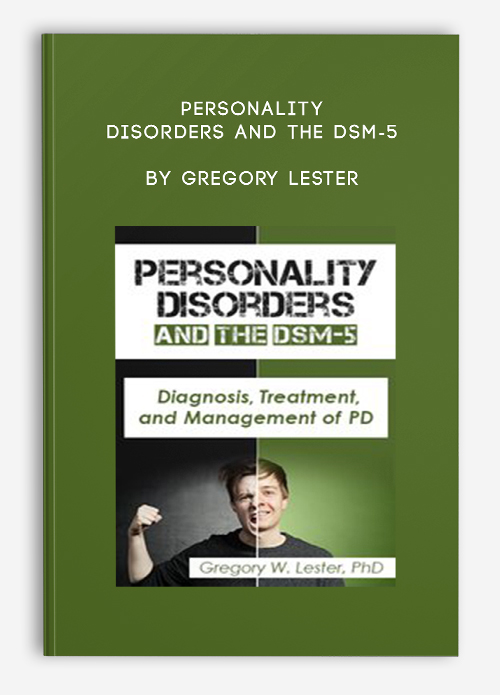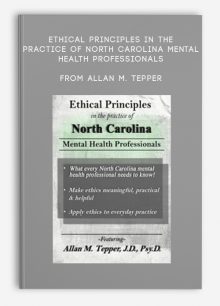Personality Disorders and the DSM-5 by Gregory Lester
$219.99 $62.00

Personality Disorders and the DSM-5 by Gregory Lester
**More information:
Get Personality Disorders and the DSM-5 by Gregory Lester at Salaedu.com
Description
Dealing with Personality Disorders
Although widely acknowledged to be the most difficult of all mental health conditions, few professionals are properly trained to assess and intervene in cases involving personality disorders. These disorders are almost always the driving force behind stalled treatment; stressful and frustrating case management; and confusing, resistive, and seemingly unmanageable clients. Unless practitioners understand how personality disorders are unique, and learn the specific methods that are required to treat and manage them, their effectiveness will be sharply diminished and the stress caused by this clientele will be unnecessarily high.
This recording is the long-anticipated DSM-5 update of the longest running, largest attended seminar on personality disorders in the world (formerly titled, “Personality Disorders in Social Work and Health Care”). This revised recording features an updated and expanded intervention section; the DSM-5 diagnostic changes; and the most current and comprehensive information available about the identification, treatment, and management of personality disorders. Designed for practitioners who know very little about the phenomenon as well as those with highly developed assessment and intervention skills, attendees gain new understanding of the phenomenon and acquire powerful interventions for the management and treatment of their most difficult and frustrating cases.
THE ESSENTIALS OF UNDERSTANDING A PERSONALITY DISORDER
- How personality disorders differ from psychiatric disorders
- Why the DSM-5 eliminated Axis II
- Why so few professionals understand personality disorders
- The unique mindset required to deal with personality disorders
THE PHENOMENON “PERSONALITY DISORDER”
- Defining a “personality disorder”
- Why personality disorders are the most difficult conditions to assess
- Why personality disorders are difficult to identify accurately
- Why psychiatric medication does not work with personality disorders
- Why traditional psychotherapies do not work with personality disorders
- Why personality disorders appear to be increasingly prevalent
THE EFFECTS OF A PERSONALITY DISORDER
- What a personality disorder does to the patient
- What a personality disorder does to the family
- Why people with personality disorders make problems worse
- How professionals keep from getting caught
EFFECTIVELY IDENTIFYING PERSONALITY DISORDERS
- The DSM-5 and personality disorders
- Effective and quick screening for a personality disorder
- Clinical confirmation of a personality disorder
- The four essential pieces of data that a diagnosis provides
- What each DSM-5 diagnosis actually means
- Research findings about the cause of personality disorders
AVOIDING INTERVENTION MISTAKES MADE BY 90% OF PRACTITIONERS
- The single reason most professionals do poorly with personality disorders
- The relationship style that is effective in dealing with personality disorders
- Why patient “history” is not the important element in effective interventions
- How treatment repairs a disordered personality
EFFECTIVE INTERVENTIONS FOR PERSONALITY DISORDERS
- The common principle guiding all effective interventions
- “Treating” versus “Managing” personality disorders
- Treatment that is designed to produce optimal functioning
- Treatment that is designed to produce adequate functioning
- Treatment that is designed to produced targeted improvement
- Management for harm-reduction
- The fundamental reframing management procedure
- The fundamental behavioral management intervention
ADDITIONAL TOPICS COVERED IN THE MANUAL
- Typical marriage pairings of individuals with personality disorders
- The occurrence of personality disorders in youth
- Prognosis of the different personality diagnoses
- How to evaluate the “treatability” of individuals with personality disorders
- Self-care for the practitioner
- Crises
More information about Medical:
Medicine is the science and practice of establishing the diagnosis, prognosis, treatment, and prevention of disease.
Medicine encompasses a variety of health care practices evolved to maintain and restore health by the prevention and treatment of illness.
Contemporary medicine applies biomedical sciences, biomedical research, genetics, and medical technology to diagnose, treat, and prevent injury and disease,
typically through pharmaceuticals or surgery, but also through therapies as diverse as psychotherapy, external splints and traction, medical devices, biologics, and ionizing radiation, amongst others.
Medicine has been around for thousands of years, during most of which it was an art (an area of skill and knowledge) frequently having connections to the religious and
philosophical beliefs of local culture. For example, a medicine man would apply herbs and say prayers for healing, or an ancient philosopher and physician would apply bloodletting according to the theories of humorism.
In recent centuries, since the advent of modern science, most medicine has become a combination of art and science (both basic and applied, under the umbrella of medical science).
While stitching technique for sutures is an art learned through practice, the knowledge of what happens at the cellular and molecular level in the tissues being stitched arises through science.
1 review for Personality Disorders and the DSM-5 by Gregory Lester
Add a review Cancel reply
Related products
HEALTH - FITNESS - LIFESTYLE - MEDICAL
HEALTH - FITNESS - LIFESTYLE - MEDICAL
HEALTH - FITNESS - LIFESTYLE - MEDICAL
HEALTH - FITNESS - LIFESTYLE - MEDICAL
HEALTH - FITNESS - LIFESTYLE - MEDICAL
Fast Confidence [How To Be More Confident │Confidence Building] from Sharon Melnick, Ph.D.
HEALTH - FITNESS - LIFESTYLE - MEDICAL
HEALTH - FITNESS - LIFESTYLE - MEDICAL
Fitness Mentors – Audio Lectures, Practice Tests and Study Guide for the NASM CPT Ex







![Fast Confidence [How To Be More Confident │Confidence Building] from Sharon Melnick, Ph.D.](https://tradersoffer.forex/wp-content/uploads/2017/05/Sharon-Melnick-Ph.D.-Fast-Confidence-How-To-Be-More-Confident-│Confidence-Building-220x261.png)


Trevis Trevis –
This is one of the most beautiful website and you can check the reviews of my website here: https://salaedu.com/clients-proof-and-reviews/